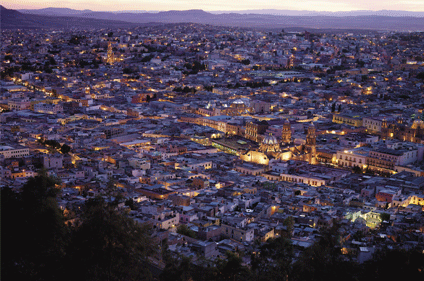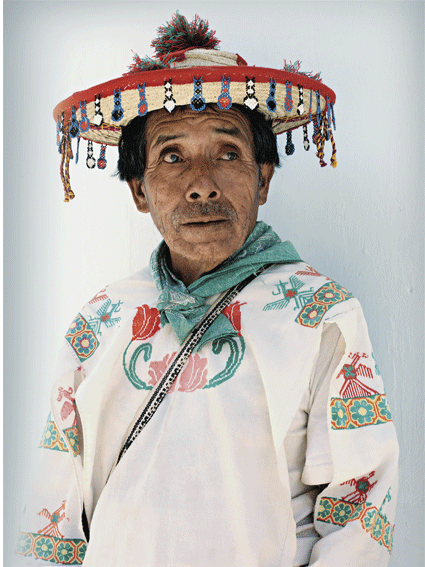
San Miguel’s reputation as an artists’ colony didn’t take off until after World War II, when former GIs, writers and bohemians from the U.S. started traveling south to attend the town’s renowned art and language schools.

Born to Be Wild
Investors are turning old colonial buildings in Real into hotels and restaurants. An artist community is growing, and
By: Patrick kelly*
Photo: Justin Guariglia*
What a difference a day makes. Twenty-four hours ago I was a stressed-out working stiff trying to find the energy to order a pizza before nodding off on the couch. Today Steppenwolf’s “Born to Be Wild” is playing in my head as I guide my metal steed across the bridge from
I met Tim Bearden 30 years ago at a junior college in
Nightfall finds the three of us at a motel in Piedras Negras.
Early the next day we race south under a cloudless blue sky through the heat of the wide-open
 By late afternoon we’ve pushed south 350 miles into
By late afternoon we’ve pushed south 350 miles into
Worst of all are the topes, or speed bumps, that infest the Mexican road system. They include pyramid-shaped wheel busters and gauntlets of iron turtles in staggered rows.
We take the two-laner that will lead us to Real de Catorce, elevation 9,045 feet.
This once wealthy silver-mining town peaked in the late 19th century, then started a slow decline. Today it draws travelers and filmmakers wanting a view of authentic Old Mexico.
From our rooftop patio at the Corral del Conde Hotel, we admire the outlying hills and the crumbling stone buildings that lend an air of lost opulence. The parish church, la Parroquia, is a neoclassical beauty attracting pilgrims hoping to see the image of Saint Francis of Assisi that’s next to the altar perform a miracle.
Outside, wearing multicolored shirts and hats, are several Huichol Indians. They consider Real de Catorce the spiritual homeland of the sacred maize, peyote and deer still integral to their culture. Each year the Huichols travel hundreds of miles to collect peyote buttons growing wild in the nearby hills.
The hallucinogenic cactus attracts another type of pilgrim, exemplified by a European couple I see sprawled on a park bench. I was about their age when I read Carlos Castaneda’s “The Teachings of Don Juan,” the 1960s best seller often credited with putting Real de Catorce on the map.
Now investors are turning old colonial buildings in Real into hotels and restaurants. An artist community is growing, and
From Real, we head southwest, and by late afternoon we’re dueling with traffic in another of
Today, this college town of 120,000 has the appeal and feel of a hip European city, with narrow, winding streets, clean and well maintained. Stylishly dressed university students stroll the sidewalks and lounge in outdoor cafes.
Sunset finds us at Cerro de la Bufa, a rocky overlook. It was here, in 1914, that Pancho Villa’s troops annihilated the loyalist forces of dictator Victoriano Huerta, a battle in the Mexican Revolution (1911 to 1921) honored with three larger-than-life statues. I stay to watch the sunset, then set off after dark.
After a tumble in the dirt I emerge onto a road and into a callejoneada, a kind of promenade to live music. Revelers celebrating a wedding twirl blue bandanas and shake their hips as they follow a brass band through the winding streets.
Next morning we take a guided tour of Mina el Eden, a once rich mine that operated for almost 400 years. We don hardhats and ride an elevator down four levels, then follow our Spanish-speaking guide through a theme-park version of the mine’s history.
Back on the surface we suit up for riding and head south. Midafternoon finds us underground again, lost in the maze of road tunnels beneath the city of
To get our bearings, we head for the most prominent landmark in Guanajuato, the colossal statue of El Pipila. Guanajuato earned its place in Mexican history on Sept. 28, 1810, when a ragtag army led by the rebel priest, Padre Miguel Hidalgo, tried to capture the city. The Spanish garrison retreated to the Alhondiga de Granaditas, a grain storage facility the rebels found impenetrable.
It looked like another false start for the revolution until a young miner, “El Pipila,” strapped a paving stone to his back, marched  through a hail of gunfire and torched the door of the granary, allowing the rebel forces to slaughter most of those inside and giving
through a hail of gunfire and torched the door of the granary, allowing the rebel forces to slaughter most of those inside and giving
Today, Alhondiga de Granaditas is an art and history museum -- but the hooks remain. The city El Pipila watches over is a gorgeous jumble of churches, museums, theaters, plazas, hotels and office buildings representing diverse styles of architecturebaroque, art nouveau, neoclassical -- and surrounded by homes painted in pastel colors. And with Guanajuato shoehorned into a narrow valley, you’re looking at a city out of a fairy tale.
More than a fourth of the 80,000 or so people living in this city are students at the
To my right is El Jardin de la Union, Guanajuato’s central meeting place with a battery of restaurants and outdoor cafes. To my left is the Teatro Juarez, a neoclassical structure with life-size statues of the Muses on the roof.
As we inch our way through the flow of pedestrians, we see -- floating above the mob in a stately procession -- the Blessed Virgin of Guanajuato.
Next morning we take in one of the most bizarre tourist attractions in
As we enter, I try not to think about the Ray Bradbury story based on the mummies of Guanajuato that haunted my youth. But I start to wig out before we even get to the bodies. The first display, “Angelitos, Tradicion, y Muerte” (“Little Angels, Tradition, and Death”) is a collection of formal black-and-white photos of parents holding their dead children.
From Guanajuato we head east along a winding, two-lane road that takes us to 8,000 feet and through a cool, pine-scented forest. Bearden leads us into
San Miguel’s reputation as an artists’ colony didn’t take off until after World War II, when former GIs, writers and bohemians from the U.S. started traveling south to attend the town’s renowned art and language schools.
 You’d need days to check out the art galleries, bookstores, museums and cantinas. The Jardin, San Miguel’s main plaza and focal point, is dominated by the Parroquia de San Miguel Arcangel, a Gothic Revival church that looks like the creation of a mad pastry chef.
You’d need days to check out the art galleries, bookstores, museums and cantinas. The Jardin, San Miguel’s main plaza and focal point, is dominated by the Parroquia de San Miguel Arcangel, a Gothic Revival church that looks like the creation of a mad pastry chef.
Late afternoon the following day we’re 500 miles north of San Miguel struggling with 120-degree heat as we try to reach the border before nightfall. I’m heading back to
We’ve arrived at a Mexican military checkpoint, where soldiers search U.S.-bound traffic for contraband. As we prepare to leave, the young officer in charge barks, “Levantela para arriba! Lift it up!” Bearden follows orders, doing a big wheelie, nearly looping his Triumph backward. The troops cheer.
It’s during those few seconds, standing under a blazing Mexican sun and watching Bearden flirt with disaster, that everything comes into focus. By the time I catch up to Bearden, “Born to Be Wild” is playing again in my head, but this time the old 1960s anthem has an upbeat Latin tempo, and I’m trying to come up with lyrics that rhyme with curva peligrosa, topes, and, especially, levantela!
*Patrick J. Kelly and Justin Guariglia are contributors to National Geographic Traveler.